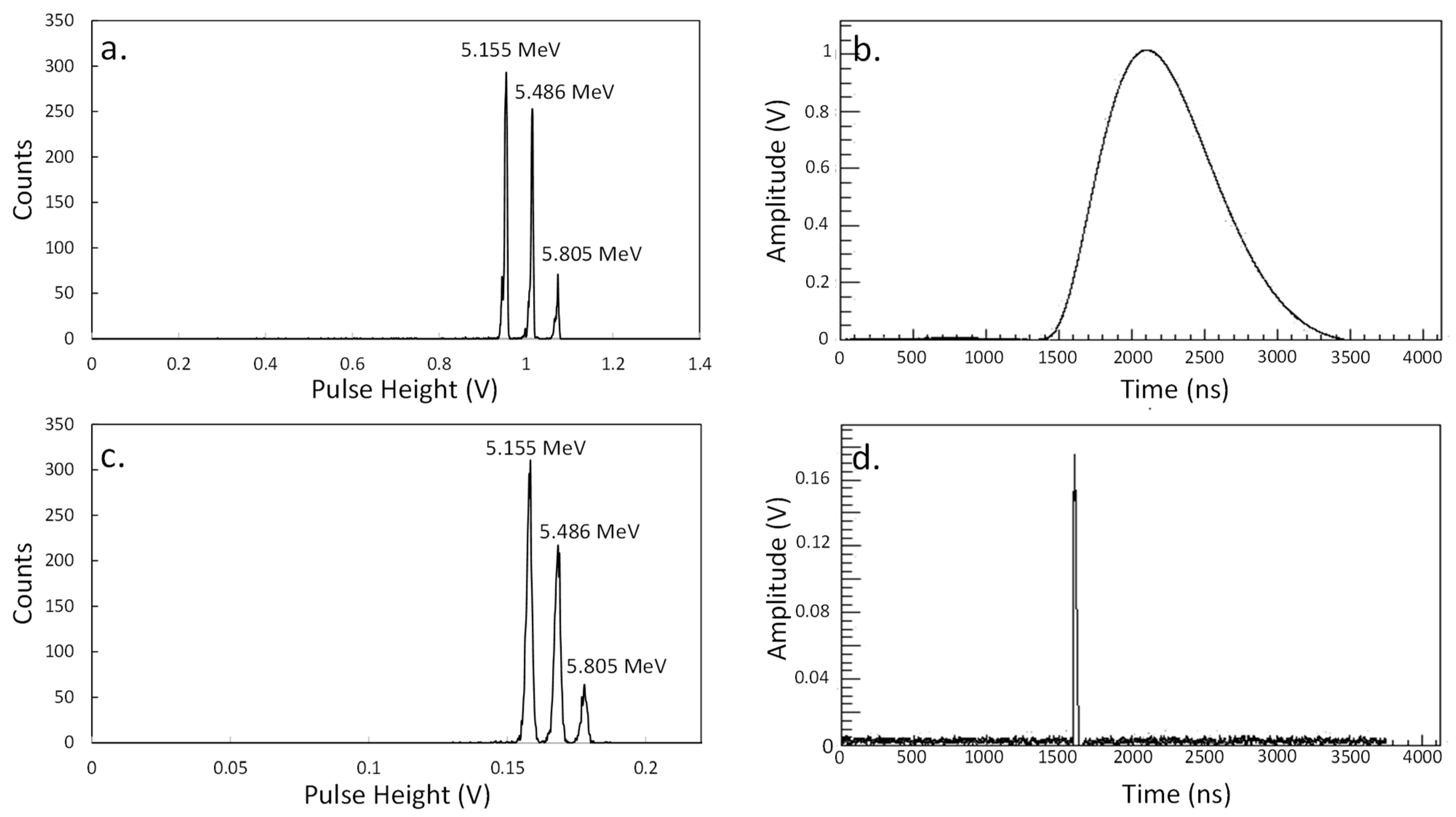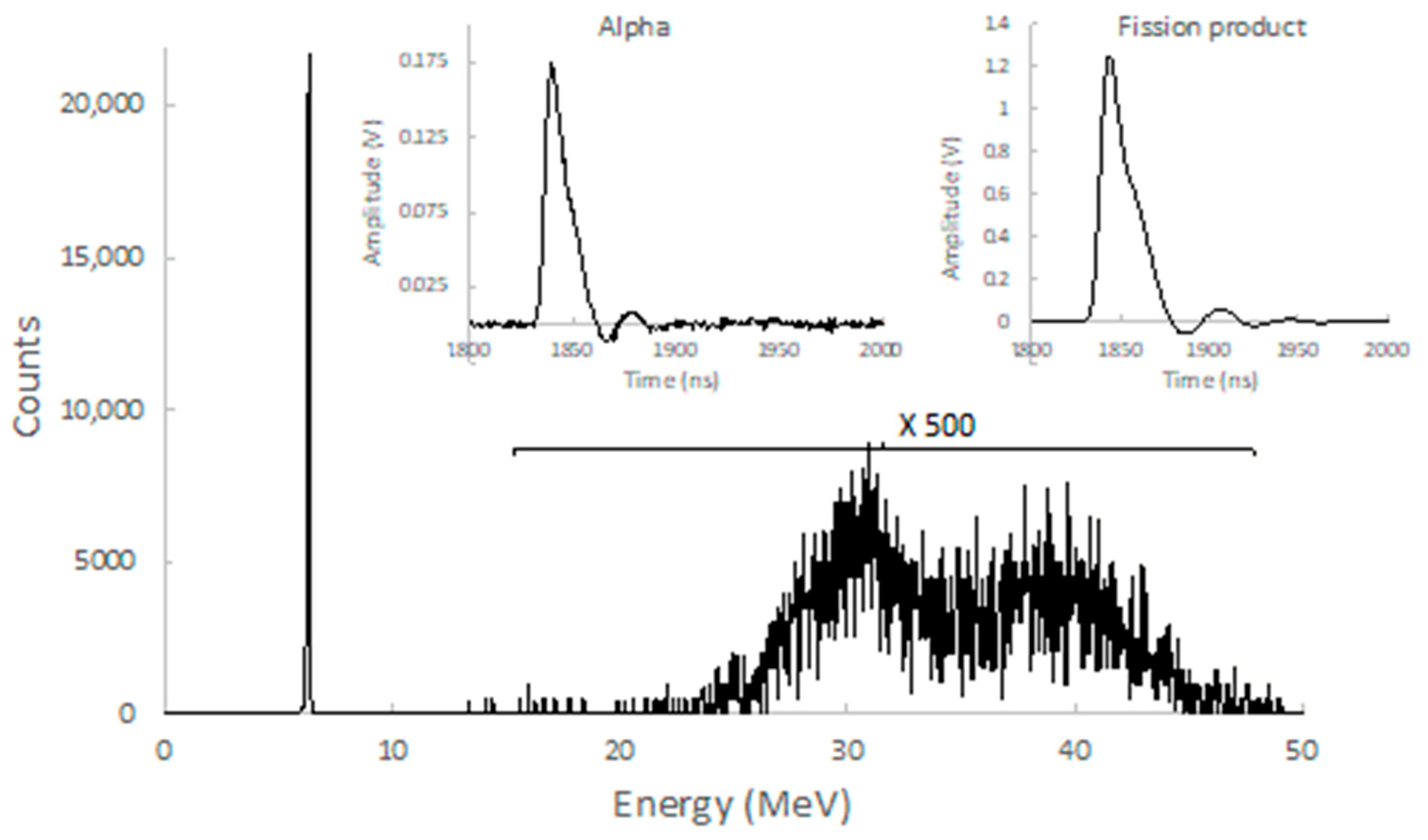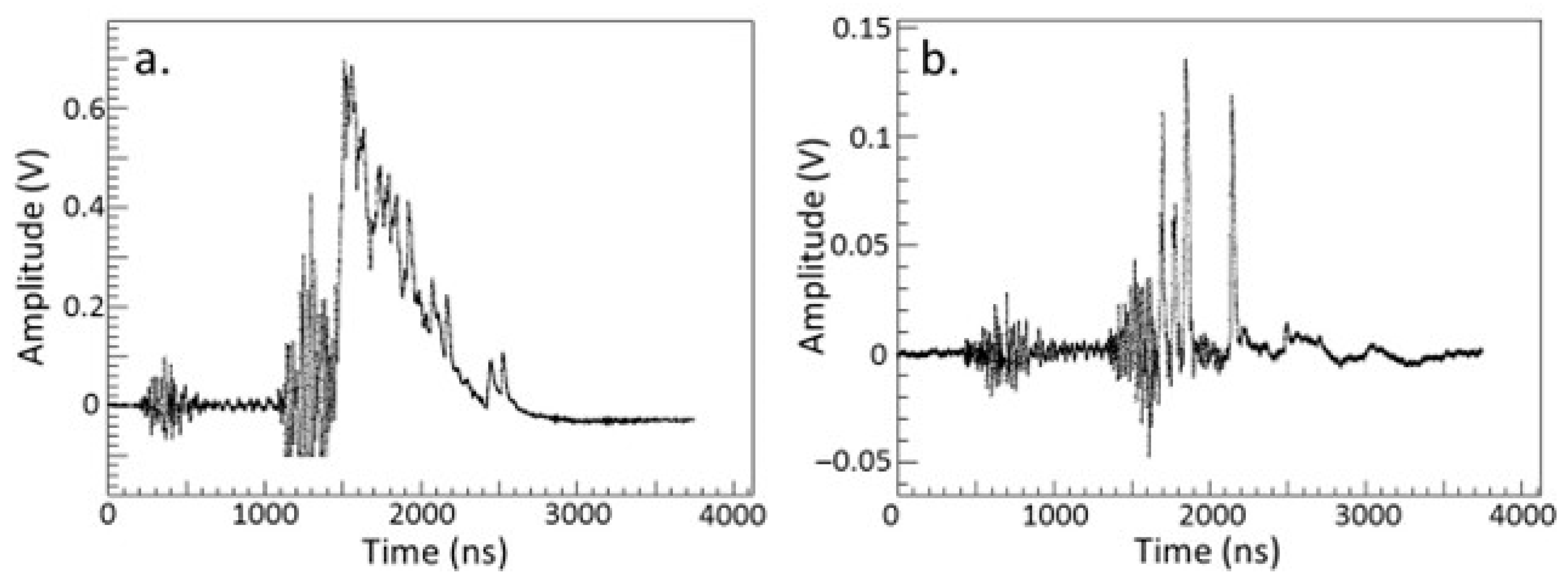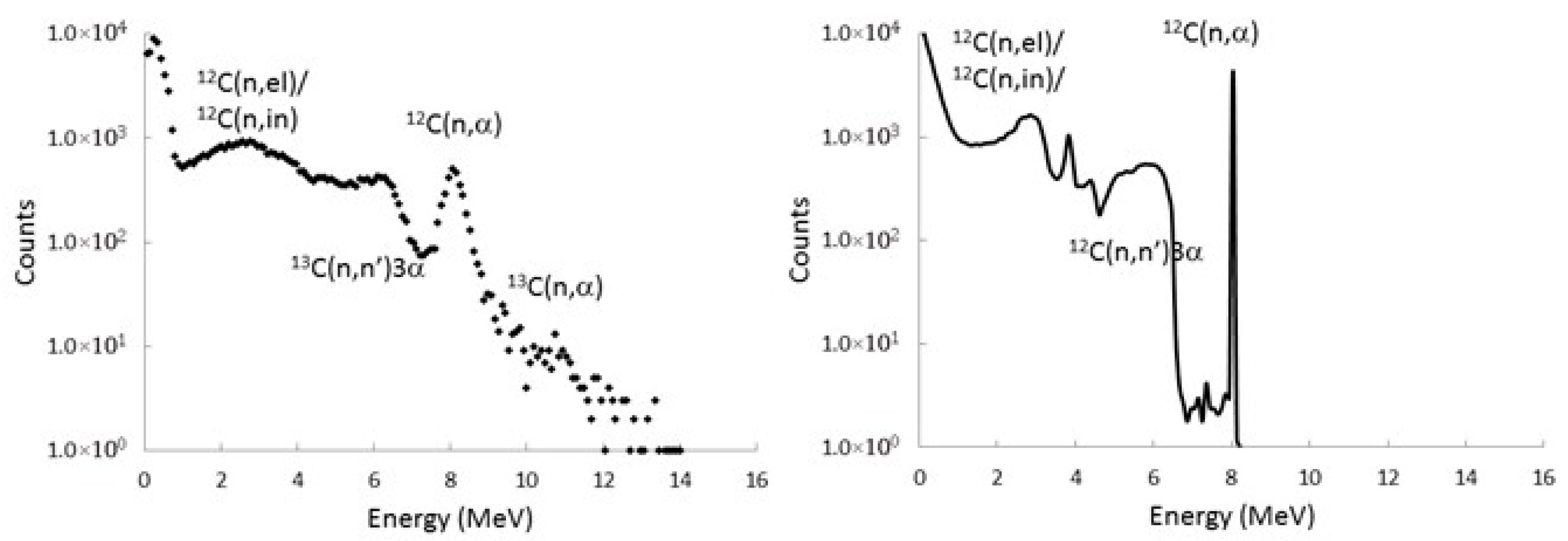Test of Diamond sCVD Detectors at High Flux of Fast Neutrons
Abstract
1. Introduction
- two 140 μm thick, 10 mm2 B3 diamond detectors;
- two CX-L spectroscopic amplifiers (1.2 μs shaping time, 9 MeV dynamic range);
- two CX-L spectroscopic amplifiers (1.2 μs shaping time, 150 MeV dynamic range);
- two C6 fast spectroscopic amplifiers (10 ns shaping time, 50 MeV dynamic range).
2. Measurements
2.1. Tests with Radioactive Sources
2.2. Tests with the Neutron Generator
3. GEANT4 Simulations
3.1. General Simulations
3.2. The Case of the 12C(n,n′)3α Measurements at the Future TOF Facility
4. Summary
Author Contributions
Funding
Data Availability Statement
Acknowledgments
Conflicts of Interest
References
- Pichoff, N.; Chance, A.; Dumas, J.; Ferrand, G.; Gougnaud, F.; Cohen, S.; Isakov, H.; Luner, J.; Mardor, I.; Perry, A.; et al. The SARAF linac project status 2023. In Proceedings of the 14th International Particle Accelerator Conference, Venice, Italy, 7–12 May 2023; p. TUPM053. [Google Scholar]
- Mardor, I.; Wilsenach, H.; Dickel, T.; Eliyahu, I.; Friedman, M.; Hirsh, T.Y.; Kreisel, A.; Sharon, O.; Tessler, M.; Vaintraub, S.; et al. Opportunities for high-energy neutrons and deuterons induced measurements for fusion technology at the Soreq applied research accelerator facility (SARAF). Front. Phys. 2023, 11, 1248191. [Google Scholar] [CrossRef]
- Frais-Kolbl, H.; Griesmayer, E.; Kagan, H.; Pernegger, H. A Fast Low-Noise Charged-Particle CVD Diamond Detector. IEEE Trans. Nucl. Sci. 2004, 51, 3833–3837. [Google Scholar] [CrossRef]
- Adam, W.; de Boer, W.; Borchi, E.; Bruzzi, M.; Colledani, C.; D’aNgelo, P.; Dabrowski, V.; Dulinski, W.; van Eijk, B.; Eremin, V.; et al. Radiation hard diamond sensors for future tracking applications. Nucl. Inst. Meth. A 2006, 565, 278–283. [Google Scholar] [CrossRef]
- Pillon, M.; Angelone, M.; Krása, A.; Plompen, A.J.M.; Schillebeeckx, P.; Sergi, M.L. Experimental response functions of a single-crystal diamond detector for 5–20.5 MeV neutrons. Nucl. Inst. Meth. A 2011, 640, 185–191. [Google Scholar] [CrossRef]
- Weiss, C.; Schuhmacher, H.; Griesmayer, E.; Zimba, A.; Weierganz, M.; Gagnon-Moisan, F.; Kasper, A. Response of CVD Diamond Detectors to 14 MeV Neutrons, CERN-ATS-Note-2012-093 TECH. Available online: https://cds.cern.ch/record/1494167?ln=en (accessed on 1 April 2025).
- Weiss, C.; Frais-Kölbl, H.; Griesmayer, E.; Kavrigin, P. Ionization signals from diamond detectors in fast neutron fields. Eur. Phys. J. A 2016, 52, 269. [Google Scholar] [CrossRef]
- Kavrigin, P.; Griesmayer, E.; Belloni, F.; Plompen, A.J.M.; Schillebeeckx, P.; Weiss, C. 13C(n,α0)10Be cross section measurement with sCVD diamond detector. Eur. Phys. J. A 2016, 52, 179. [Google Scholar] [CrossRef]
- Liu, J.; Jiang, H.; Cui, Z.; Hu, Y.; Bai, H.; Fan, T.; Chen, J.; Gao, Y.; Yang, X.; Zhang, G. Simultaneous measurement of energy spectrum and fluence of neutrons using a diamond detector. Sci. Rep. 2022, 12, 12022. [Google Scholar] [CrossRef] [PubMed]
- Osipenko, M.; Bellucci, A.; Ceriale, V.; Corsini, D.; Gariano, G.; Gatti, F.; Girolami, M.; Minutoli, S.; Panza, F.; Pillon, M.; et al. Upgrade of the compact neutron spectrometer for high flux environments. Nucl. Inst. Meth. A 2018, 883, 14–19. [Google Scholar] [CrossRef]
- Available online: http://www.cividec.at (accessed on 1 April 2025).
- MPaul, M.; Tessler, M.; Friedman, M.; Halfon, S.; Weissman, L. The Liquid-Lithium Target at the Soreq Applied Research Accelerator Facility. Eur. Phys. J. A 2022, 58, 207. [Google Scholar] [CrossRef]
- Frégeau, M.O.; Oberstedt, S.; Brys`, T.; Gamboni, T.; Geerts, W.; Hambsch, F.-J.; Oberstedt, A.; Vidali, M. First use of single-crystal diamonds as fission-fragment detector. Nucl. Instr. Meth. A 2015, 791, 58–64. [Google Scholar] [CrossRef]
- Beliuskina, O.; Strekalovsky, A.O.; Aleksandrov, A.A.; Aleksandrova, I.A.; Devaraja, H.M.; Heinz, C.; Heinz, S.; Hofmann, S.; Ilich, S.; Imai, N.; et al. Pulse-height defect in single-crystal CVD diamond detectors. Eur. Phys. J. 2017, 53, 32. [Google Scholar] [CrossRef]
- Available online: http://www.vniia.ru/eng/production/neitronnie-generatory/neytronnye-generatory.php (accessed on 1 April 2025).
- Antolković, B.; Dolenec, Z. The neutron-induced 12C(n, n′)3α reaction at 14.4 MeV in a cinematically complete experiment. Nucl. Phys. A 1975, 237, 235–252. [Google Scholar] [CrossRef]
- Garcia, A.R.; Mendoza, E.; Cano-Ott, D.; Nolte, R.; Martinez, T.; Algora, A.; Tain, J.L.; Banerjee, K.; Bhattacharya, C. New physics model in GEANT4 for the simulation of neutron interactions with organic scintillation detectors. Nucl. Instrum. Meth. A 2017, 868, 73–81. [Google Scholar] [CrossRef]
- Osipenko, M.; Ripani, M.; Ricco, G.; Caiffi, B.; Pompili, F.; Pillon, M.; Verona-Rinati, G.; Cardarelli, R. Response of a diamond detector sandwich to 14MeV neutrons. Nucl. Instr. Meth. A 2016, 817, 19–25. [Google Scholar] [CrossRef]
- Agostinelli, K.A.; Apostolakis, J.; Araujo, H.; Arce, P.; Asai, M.; Axen, D.; Banerjee, S.; Barrand, G.J.N.I.; Behner, F.; Bellagamba, L.; et al. GEANT4—A simulation toolkit. Nucl. Instr. Meth. A 2003, 506, 250–303. [Google Scholar] [CrossRef]
- Freer, M.; Fynbo, H.O.U. The Hoyle state in 12C. Prog. Part. Nucl. Phys. 2014, 78, 1–23. [Google Scholar] [CrossRef]
- Beard, M.; Austin, S.M.; Cyburt, R. Enhancement of the triple alpha rate in a hot dense medium. Phys. Rev. Lett. 2017, 119, 112701. [Google Scholar] [CrossRef] [PubMed]
- Bishop, J.; Parker, C.E.; Rogachev, G.V.; Ahn, S.; Koshchiy, E.; Brandenburg, K.; Brune, C.R.; Charity, R.J.; Derkin, J.; Dronchi, N.; et al. Neutron-upscattering enhancement of the triple-alpha process. Nat. Commun. 2022, 13, 2151. [Google Scholar] [CrossRef]
- Pigni, M.; DeBoer, R.; Dimitriou, P. Summary Report of the IAEA Consultants’ Meetings; IEEA: Vienna, Austria, 2022; Available online: https://www-nds.iaea.org/publications/indc/indc-nds-0853.pdf (accessed on 1 April 2025).
- Liu, J.; Cui, Z.; Hu, Y.; Bai, H.; Chen, Z.; Xia, C.; Fan, T.; Chen, J.; Zhang, G.; Ruan, X.; et al. 12C(n,n+ 3α) and 12C(n, α0)9Be cross sections in the MeV neutron energy region. Phys. Lett. B 2023, 842, 137985. [Google Scholar] [CrossRef]
- Osipenko, M.; Pompili, F.; Ripani, M.; Pillon, M.; Ricco, G.; Caiffi, B.; Verona-Rinati, G.; Argiro, S. Test of a prototype neutron spectrometer based on diamond detectors in a fast reactor. In Proceedings of the 4th International Conference on Advancements in Nuclear Instrumentation Measurement Methods and Their Applications (ANIMMA), Lisbon, Portugal, 20–24 April 2015. [Google Scholar] [CrossRef][Green Version]





| Reaction | Q-Value (MeV) | Threshold (MeV) | Cross-Section (mb) |
|---|---|---|---|
| 12C(n,el)12C | 0 | 0 | ~850 |
| 13C(n,a)10Be | −3.836 | 4.134 | ~11 |
| 12C(n,inl)12C | −4.439 | 4.81 | ~200 |
| 12C(n,a)9Be | −5.702 | 6.182 | ~65 |
| 12C(n,n′)3α | −7.275 | 7.886 | ~200 |
| 12C(n,p)12B | −13.732 | 14.887 | ~1 |
Disclaimer/Publisher’s Note: The statements, opinions and data contained in all publications are solely those of the individual author(s) and contributor(s) and not of MDPI and/or the editor(s). MDPI and/or the editor(s) disclaim responsibility for any injury to people or property resulting from any ideas, methods, instructions or products referred to in the content. |
© 2025 by the authors. Licensee MDPI, Basel, Switzerland. This article is an open access article distributed under the terms and conditions of the Creative Commons Attribution (CC BY) license (https://creativecommons.org/licenses/by/4.0/).
Share and Cite
Weissman, L.; Shor, A.; Vaintraub, S. Test of Diamond sCVD Detectors at High Flux of Fast Neutrons. Particles 2025, 8, 75. https://doi.org/10.3390/particles8030075
Weissman L, Shor A, Vaintraub S. Test of Diamond sCVD Detectors at High Flux of Fast Neutrons. Particles. 2025; 8(3):75. https://doi.org/10.3390/particles8030075
Chicago/Turabian StyleWeissman, Leo, Asher Shor, and Sergey Vaintraub. 2025. "Test of Diamond sCVD Detectors at High Flux of Fast Neutrons" Particles 8, no. 3: 75. https://doi.org/10.3390/particles8030075
APA StyleWeissman, L., Shor, A., & Vaintraub, S. (2025). Test of Diamond sCVD Detectors at High Flux of Fast Neutrons. Particles, 8(3), 75. https://doi.org/10.3390/particles8030075





